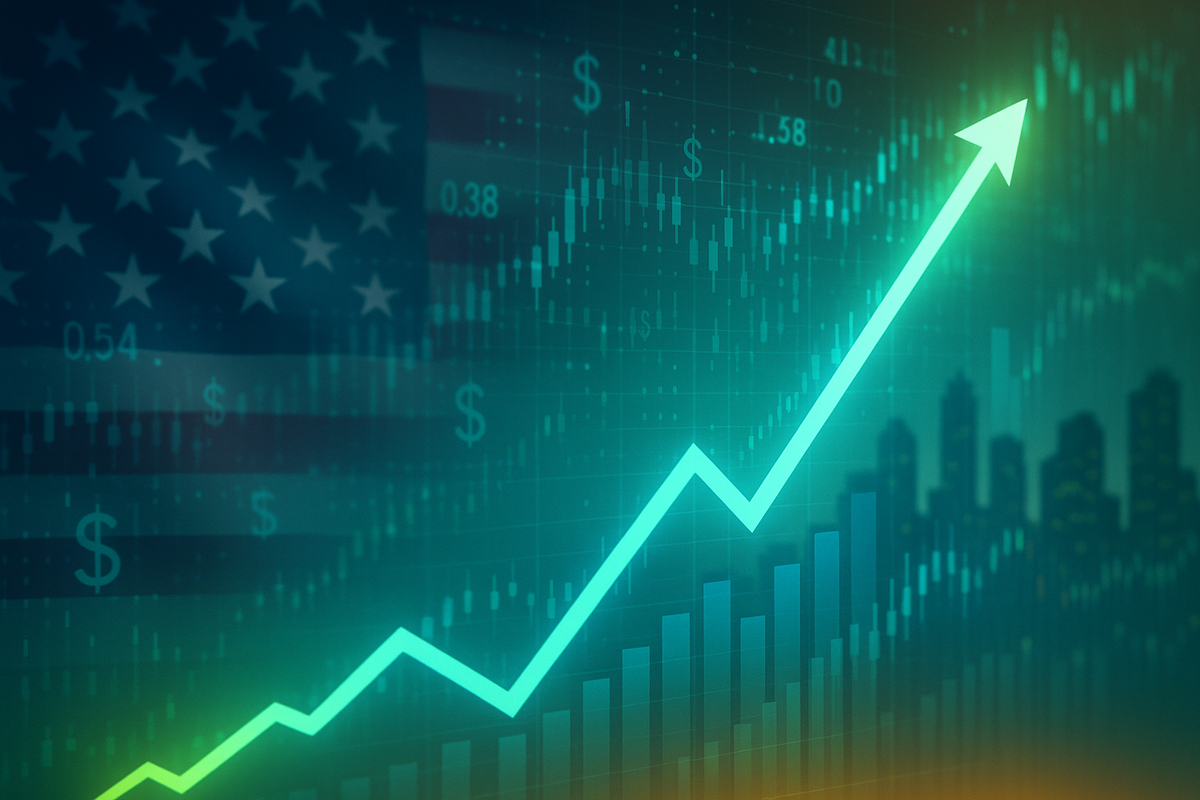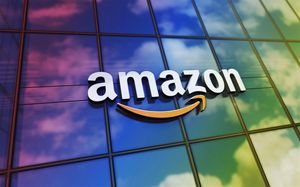
The U.S. economy experienced a notable resurgence in the second quarter of 2025, with real Gross Domestic Product (GDP) expanding at an annualized rate of 3.0%. This figure, surpassing economists' expectations and marking a significant turnaround from the 0.5% contraction in Q1, initially painted a picture of robust recovery. However, a closer examination of the underlying data reveals a more complex narrative, with concerns mounting that this headline growth may be an "economic mirage," largely driven by a sharp decline in imports rather than a fundamental strengthening of private sector demand.
This rebound, while seemingly positive, has sparked a critical debate among economists and market analysts regarding its sustainability. The substantial decrease in imports, attributed to businesses front-loading purchases in anticipation of new tariffs, appears to have artificially inflated the GDP number. This raises questions about the true health of the U.S. economy and whether the current growth trajectory can be maintained in the face of softening labor markets, persistent policy uncertainty, and elevated interest rates.
A Closer Look at the Q2 Rebound and Its Significance
The 3.0% annualized GDP growth in Q2 2025, as reported by the U.S. Bureau of Economic Analysis (BEA), was a welcome sight after a sluggish start to the year. This growth was primarily propelled by two key factors: a substantial decrease in imports and an increase in consumer spending. Consumer spending, a vital engine of the U.S. economy, saw a 1.4% rise in Q2, accelerating from the 0.5% increase in the preceding quarter.
However, this positive momentum was partially offset by declines in other critical areas. Private sector investment plunged by 15.6%, and exports fell by 1.8% in Q2, indicating a cautious approach from businesses. Federal government spending also continued its downward trend for the second consecutive quarter. Inflationary pressures showed signs of easing, with the Personal Consumption Expenditures (PCE) price index increasing by 2.1% in Q2, down from 3.7% in Q1, moving closer to the Federal Reserve's 2% target. Despite the strong headline GDP figure, the labor market presented a more nuanced picture, with the July 2025 jobs report indicating a cooling trend characterized by a slowdown in hiring and an uptick in the unemployment rate.
The most significant factor influencing the Q2 GDP figure was the dramatic decline in imports, which plummeted by 30.3%. This sharp reversal from a 37.9% surge in Q1 is largely attributed to businesses strategically front-loading purchases in the first quarter to circumvent anticipated new tariffs, leading to a subsequent reduction in imports in Q2. Since imports are subtracted in the calculation of GDP, this substantial decrease acted as a significant tailwind, boosting the headline growth number and masking potentially softer underlying domestic demand. This dynamic has led many economists to label the Q2 growth as a "statistical illusion," with a more accurate measure of underlying demand, "final sales to private domestic purchasers," increasing by only 1.2%—the weakest since late 2022.
Initial market reactions to the Q2 GDP report were relatively stable, with investors closely monitoring the Federal Reserve's stance on interest rates. Equity markets, including the S&P 500 (SPX), had recovered by the quarter's end, reaching new highs. Some economists suggested that the robust GDP data might provide the Federal Reserve with more flexibility to consider interest rate cuts by its September meeting, anticipating a moderation in consumer spending in the subsequent quarters. However, the underlying concerns about the sustainability of this growth continue to temper outright optimism.
Winners and Losers in a Tariff-Driven Economy
The U.S. economy's Q2 2025 rebound, while superficially positive, creates a complex landscape of potential winners and losers, largely shaped by the interplay of tariff-driven import dynamics, resilient consumer spending, and a cautious approach to private investment.
Potential Winners:
Domestic manufacturers stand to be significant beneficiaries, particularly those in industries now subject to higher import tariffs. Sectors like automotive parts, semiconductors, and certain consumer goods could see increased demand for their domestically produced alternatives as businesses seek to avoid tariff-related costs. Companies with robust domestic operational footprints and supply chains, such as General Motors (NYSE: GM) or Intel (NASDAQ: INTC), may accelerate commercial actions and boost local production, gaining a competitive edge.
The consumer discretionary sector is also poised for gains, fueled by the observed increase in consumer spending. Retailers offering apparel, home improvement goods, and general merchandise, such as Lowe's (NYSE: LOW) and Walmart (NYSE: WMT), could thrive. Hospitality and travel companies, including major airlines like Delta Air Lines (NYSE: DAL) and hotel chains like Marriott International (NASDAQ: MAR), may also see increased demand as consumers allocate more spending towards experiences. E-commerce platforms, regardless of the specific goods being purchased, are likely to benefit from the overall uptick in consumer activity. Furthermore, companies with strong balance sheets and ample cash reserves are well-positioned to navigate a period of decreased private investment, potentially acquiring assets or smaller competitors at attractive valuations.
Potential Losers:
Importers and retailers heavily reliant on imported goods face significant headwinds. Businesses with substantial exposure to countries targeted by tariffs, such as department stores with a high apparel category skew and significant China exposure, could experience increased costs that may be passed on to consumers, potentially leading to decreased demand. Companies like Macy's (NYSE: M) or Kohl's (NYSE: KSS) could be particularly vulnerable due to their lower operating margins. International shipping and logistics companies, such as FedEx (NYSE: FDX) and UPS (NYSE: UPS), are likely to see a direct reduction in the volume of goods being shipped internationally due to declining imports.
Capital goods manufacturers, which produce machinery and equipment for other businesses, will likely face reduced demand as private investment decreases. Companies like Caterpillar (NYSE: CAT) could see a slowdown in orders. Similarly, the commercial and industrial construction sectors may experience a downturn, as decreased business investment translates to fewer new commercial buildings or industrial facilities. Financial institutions heavily involved in corporate lending, mergers, and acquisitions, such as JPMorgan Chase (NYSE: JPM) and Bank of America (NYSE: BAC), might experience a slowdown in activity, and while lower interest rates could stimulate some lending, they can also compress net interest margins. A cooling labor market could also eventually dampen consumer confidence and spending, particularly in discretionary sectors, potentially impacting the bottom lines of even resilient retailers if consumers become more cautious.
Industry Impact and Broader Implications
The U.S. GDP rebound in Q2 2025, particularly one heavily influenced by tariff-induced import declines, presents a complex picture with far-reaching implications for various industries, global trade partners, and future policy decisions. While the headline growth figure offers a temporary sense of relief, its underlying drivers raise significant questions about the sustainability of this economic expansion.
This event fits into a broader trend of increasing protectionism and trade tensions globally. The strategic front-loading of imports in Q1 to avoid new tariffs, followed by a subsequent decline in Q2, highlights how businesses are adapting to an unpredictable trade environment. This behavior, while temporarily boosting GDP, can lead to supply chain disruptions, increased costs for consumers, and reduced efficiencies in the long run. Industries heavily reliant on global supply chains, such as automotive and electronics manufacturing, face ongoing challenges in navigating these shifts. Conversely, domestic manufacturing sectors may experience a temporary boost as demand shifts towards locally produced goods, potentially accelerating reshoring initiatives.
The ripple effects on competitors and partners are substantial. Historically, robust U.S. economic growth has positively impacted the global economy through trade linkages. However, a U.S. GDP rebound driven by protectionist tariff policies could have adverse global consequences. Fitch Ratings, for instance, has projected a sharp slowdown in global economic growth, partly due to a "U.S. tariff shock," potentially leading to a substantial loss in global income. Export-oriented economies, particularly in East Asia and the eurozone, are vulnerable to weaker growth in China and higher U.S. tariffs, which could lead to reduced exports and economic contraction in those regions. The risk of retaliatory tariffs and escalating trade wars remains a significant concern, threatening to fragment global supply chains further and increase costs for businesses and consumers worldwide.
From a regulatory and policy perspective, the Q2 GDP rebound, if attributed to tariffs, could reinforce existing protectionist trade policies or even lead to further tariff implementations. This creates significant policy uncertainty, which can deter long-term business investment and spending. On the monetary policy front, if tariffs lead to increased inflation, as some forecasts suggest, the Federal Reserve might be hesitant to cut interest rates or could even consider further tightening to combat inflationary pressures. This could result in higher real interest rates, further dampening investment and consumption. Fiscal policies, such as potential tax cuts and government spending, will also interact with the tariff regime, with rising budget deficits potentially exacerbating long-term growth challenges.
Historical precedents for a widespread "tariff shock" of this magnitude are scarce in recent economic history, making direct comparisons challenging. While the U.S. economy has experienced numerous cyclical fluctuations and rebounds, the specific dynamics of a tariff-driven surge and subsequent decline in imports are relatively unique. This makes it difficult to predict the long-term sustainability of such growth. Sustainable economic growth typically relies on factors like investment in capital and infrastructure, innovation, sound economic policies, and social and environmental sustainability. Tariffs, by increasing costs, fostering uncertainty, and potentially leading to trade wars, can undermine these fundamental drivers, raising concerns about the long-term health of the U.S. and global economies.
What Comes Next
The coming months will be crucial in determining whether the Q2 2025 GDP rebound represents a genuine strengthening of the U.S. economy or merely a statistical anomaly driven by trade distortions. In the short term, the focus will be on how quickly businesses draw down the stockpiled imports from Q1. A rapid depletion could lead to a renewed, albeit potentially smaller, increase in imports in subsequent quarters, which would then act as a drag on GDP. Conversely, if businesses remain cautious due to ongoing tariff uncertainty, the decline in imports could persist, continuing to artificially inflate GDP figures.
A key area to watch is consumer behavior. While consumer spending showed resilience in Q2, a cooling labor market with moderating job growth and rising unemployment claims could eventually dampen consumer confidence and spending. This could lead to a slowdown in the consumer discretionary sector, impacting retailers and service providers. Businesses will need to adapt their strategies, potentially focusing on domestic sourcing and production to mitigate tariff risks, or exploring new markets to diversify their supply chains. This could present opportunities for companies that can quickly pivot and innovate in a changing trade landscape.
In the long term, the sustainability of economic growth will hinge on fundamental factors beyond trade dynamics. Investment in capital and infrastructure, innovation, and sound economic policies will be paramount. If the current trade policies persist, there's a risk of continued supply chain fragmentation and higher costs, which could stifle productivity growth and lead to higher inflation. This could force the Federal Reserve to maintain a tighter monetary policy for longer, further constraining economic activity.
Potential scenarios include a "soft landing" where the economy gradually decelerates without entering a recession, or a "hard landing" where the underlying weaknesses, masked by the Q2 rebound, lead to a more significant downturn. Investors should closely monitor inflation data, labor market reports, and consumer confidence indicators. The Federal Reserve's decisions regarding interest rates will also be a critical factor, as any further tightening or a delayed easing could significantly impact market sentiment and economic growth. Companies that demonstrate agility in adapting to evolving trade policies and a focus on long-term innovation are likely to be better positioned to navigate the challenges and opportunities that lie ahead.
Conclusion
The U.S. economy's 3.0% annualized GDP growth in the second quarter of 2025, while a welcome headline, presents a nuanced and potentially misleading picture of underlying economic strength. The key takeaway is that this rebound appears to be significantly influenced by a sharp decline in imports, largely a consequence of businesses front-loading purchases in anticipation of new tariffs. This "economic mirage" raises serious questions about the sustainability of the growth and the true health of private sector demand.
Moving forward, the market will be closely scrutinizing the composition of future GDP reports, looking beyond the headline figures to assess the genuine drivers of economic activity. The interplay of trade policies, consumer behavior, and business investment will be critical in shaping the economic trajectory. While some domestic industries and consumer-facing sectors may experience short-term benefits, the broader implications of protectionist trade policies, including potential global slowdowns and inflationary pressures, pose significant risks.
Investors should remain cautious and focus on companies with strong fundamentals, diversified supply chains, and a proven ability to adapt to evolving market conditions. Key indicators to watch in the coming months include inflation rates, labor market trends, consumer confidence surveys, and any shifts in trade policy. The Federal Reserve's response to these mixed signals, particularly regarding interest rate adjustments, will also be a crucial determinant of market sentiment and economic stability. The Q2 GDP rebound, while offering a temporary reprieve, underscores the need for a deeper understanding of the forces at play and a vigilant approach to navigating the complex economic landscape ahead.






